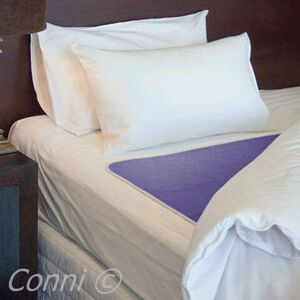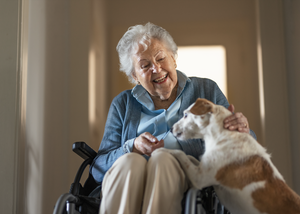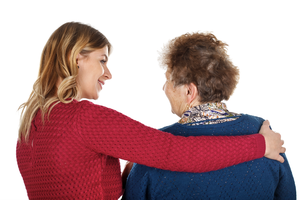At Access Rehabilitation Equipment, we commit to providing you and your loved ones solutions for life! Fitting your lifestyle, each aid and equipment is tailored to the unique challenges you are facing, so work with us to find the independence and mobility you want!

When caring for an aging parent, there is a 50% chance that they will experience incontinence or bladder control issues at some point in their life. Many seniors are embarrassed to talk about this issue and are reluctant to ask for help, but being incontinent is not something to tolerate. Although it’s fairly common, urinary incontinence should not be regarded as an inevitable part of aging. In this guide, we’ll walk you through practical steps and tips to make this condition more manageable. Learn more about incontinence, its causes, and appropriate ways to help you provide your parents the highest level of care.
What is incontinence?
Incontinence refers to the involuntary loss of control over the release of urine or stool from the body. It means, a person cannot hold or control these bodily functions as they normally would, leading to unintentional leakage or discharge. Incontinence can occur for various reasons, including changes in the body due to aging, medical conditions, certain medications, or surgical procedures. There are different types of incontinence, and each can vary in severity:
-
Urge incontinence: When you feel a strong and sudden urge to urinate followed by loss of urine before you can reach a toilet, your incontinence may be related to urge incontinence, commonly known as an overactive bladder.
-
Stress incontinence: This type of incontinence refers to “stress” as it relates to the physical strain that triggers urine leakage, such as when you jump, cough, sneeze or laugh, and any movements that put pressure on the bladder. Stress incontinence is more common in women due to factors like pregnancy and childbirth.
-
Overflow incontinence: If you have the urge to urinate but can release only a little amount of urine, you might have overflow incontinence. This condition can occur due to a weak or underactive bladder muscle or a blockage in the urinary tract system. Due to your bladder not emptying properly as it should, it may leak urine even when you feel no urge to pee.
-
Mixed incontinence: Mixed incontinence occurs when both urge and stress incontinence are present. It includes frequent urges to urinate (overactive bladder) combined with leaks during physical activities, coughing, or sneezing (stress incontinence). This condition most commonly affects women and in frail older people of either gender.
-
Functional incontinence: Other conditions, such as neurological disorders, stroke complications, or arthritis, can hinder your ability to reach a toilet in time to urinate, resulting in this type of incontinence. You lose control of your bladder because these underlying conditions make it hard to get to a bathroom or prevent you from recognizing that you need to pee.
-
Total incontinence: Total incontinence refers to the continuous and complete loss of control over urination, resulting in constant urine leakage. This type of incontinence occurs when the muscle responsible for regulating the release of urine, the sphincter muscle, is no longer functioning.
How to speak to your elderly parent about incontinence?
Talking with your elderly parent about incontinence might be difficult, but it’s something that can’t go ignored. Without intervention and treatment, it can lead to severe health issues like skin irritations, bedsores, and urinary tract infections.
If your elderly parent with incontinence regularly experiences accidents, it’s crucial to do something about it. While it might seem daunting, you can approach the conversation with empathy and understanding and with a little bit of planning. Take the time to prepare in advance with these simple steps.
-
Try to be understanding.
Providing care for an elderly parent with incontinence is indeed a challenging task. The need for frequent changes, additional laundry, and monitoring fluid intake can take your time away from work, hobbies, and other responsibilities. While it’s natural to experience frustration, keep these emotions from affecting your conversation.
When discussing this sensitive topic, keep your calm, balanced, and positive tone. Rather than making accusations, focus on explaining how incontinence impacts your role as a caregiver. If your parent has a diagnosed underlying health issue contributing to the problem, tell them you understand their situation and that you want to help.
-
Refrain from calling them “Nappies.”
When suggesting care solutions, use age-appropriate terminology. Instead of referring to “nappies” or “adult pull-ups,” which may carry negative connotations, use terms like “incontinence pads,” “liners,” “shield,” or “disposable underwear.” If your elderly parent worries about people noticing their use of these products, ensure them that modern options are discreet and compact.
-
Select the best time and place to talk.
To make your parents not to feel embarrassed when talking about incontinence, be thoughtful about when and where you approach this topic. For instance, you might want to discuss it with your parents during a meal they enjoy or while engaging in one of their favorite activities. When your senior feels relaxed and comfortable in their environment, they are more likely to respond positively.
How do you care for someone who is incontinent?
Taking care of someone with incontinence can be a challenging responsibility, but it’s crucial to provide them with support they need. However, if you’re not a certified caregiver, you might not know where to start to ensure your loved one’s comfort throughout the process. Fortunately, there are some things you can do to help them in maintaining their dignity and managing their condition effectively.
-
Talk to their doctor about their condition
Talking to their doctor will provide more specific details about the type of incontinence they are dealing with, which is essential for their long-term care. Each type of incontinence requires different treatment approaches, so having this information upfront can enable you and the doctor to create a suitable course of action. Consider discussing potential medication, physical therapy, or lifestyle changes that might help to manage incontinence.
-
Show Empathy
Incontinence often carries a stigma, especially when it comes to older individuals. However, having incontinence doesn’t imply a decline in mental well-being or a lack of awareness. In fact, this condition can affect people of all ages, regardless of their overall health. Incontinence can be a distressing and embarrassing issue for those experiencing it. Your loved one may feel ashamed, anxious, or frustrated about their situation, so it’s important to listen and to provide them emotional support. If you need additional assistance, consider asking your doctor for recommendations regarding support groups or mental health professionals.
-
Encourage Open Communication
In addition to showing empathy, try to keep communication open and be honest about their condition. Also encourage them to express their thoughts and emotions. If they are uncomfortable discussing their incontinence with you, it might be beneficial to recommend consulting a healthcare professional or a counselor.
-
Watch out for the triggers
Incontinence can result from specific foods, beverages, and medications, though these triggers differ from person to person. Try to understand what triggers incontinence in your loved one to reduce its frequency. You can achieve this by maintaining a food journal and regularly reviewing it for patterns. Typical triggers include alcohol, caffeine, chocolate, tomatoes, spicy foods, and sugar. Instead, opt for foods that support bladder health. Some people also might be triggered by inadequate or excessive fluid intake.
-
Make a toilet schedule
Making a daily routine that includes scheduled toilet visits at specific times can be another effective method for managing incontinence. This approach is especially helpful if your loved one is also dealing with any form of dementia. Bathroom schedules can help in conditioning the bladder to empty at scheduled times during the day without having to think about it. This would involve scheduling regular bathroom breaks, even if they don’t have the urge to go. You can start with intervals of one to two hours and adjust the schedule as needed to align with their body’s needs. Setting up toilet schedules can help to prevent accidents and to reduce the risk of urinary tract infections.
-
Choose the appropriate clothing
Choose clothing with features like elastic waistbands and loose-fitting designs that are easy to put on and take off. Moisture-wicking materials can help keep the skin dry and reduce irritation. Avoid clothing with too many fastenings, clasps, or zippers to make dressing and undressing easier. By doing this, it can greatly improve their daily comfort and independence.
-
Have incontinence products ready
When caring for your loved one with incontinence, keep a supply of different types of incontinence products to manage leaks or accidents and make cleanup easier.
Products to help with incontinence:
Once you know what type of incontinence your elderly parents have, there are products available to help them deal with accidents and feel comfortable and confident at home and on the go. Consider some or all of these incontinence products for your parents and keep ample inventory levels on hand.
-
Reusable/washable undergarments: Waterproof undergarments are designed to provide a protective barrier against leaks and moisture. They help keep someone with incontinence dry and comfortable while preventing liquid from seeping through to clothing or bedding. These reusable undergarments are perfect for seniors who are looking for more traditional and discreet protection.

-
Chair Pads: Designed for easier incontinence management, chair pads provide a reliable protective covering for any seating surface at home or in the car. These incontinence products are available in various colors, materials, designs, and absorbency levels, making them a convenient choice for managing leakage, odors, and bacteria control in seniors.

-
Bed Pads: Achieving a peaceful night’s sleep can be challenging when dealing with incontinence. Whether it’s frequent wake-ups or needing to change your sheets—bed pads are one solution to protect your beddings and mattress. These pads are placed on top of the bed or under the person to provide additional layer of protection, helping to keep the bed dry while managing incontinence-related issues.

-
Mattress Protector: Mattresses are often very expensive and the hardest to clean, so covering your mattress with a waterproof bed sheet or mattress protector is always a good idea. These covers protect your mattress from incontinence-related issues and maintain cleanliness by preventing stains caused by sweat, saliva, vomit, or other liquids that might come into contact with the bed.
Ways to help combat incontinence:
In addition to ensuring your parents have the required medications, aids, and equipment, here are some other approaches to help them manage their incontinence effectively:
1. Limit drinks before bedtime
Make your fluid intake on a schedule to help train your bladder when to fill and when to empty. Also, limit your fluid intake after 6 in the evening to reduce nighttime urination and incontinence issues. Aim for a daily total fluid intake between 40 and 60 ounces. Insufficient fluid intake during the day can concentrate the urine and irritate the lining of the bladder, while too much fluid may result in more frequent urination, leakage, and nighttime trips.
2. Maintain a healthy weight
Having a healthy body weight will improve a person’s health in many ways, one of which is a decrease in incontinence. For many people, losing 10% of their body weight can result in a 50% lower risk of experiencing incontinence episodes. Here are some tips for maintaining a healthy weight:
-
Regular Exercise: For people aged 18 and older, it is recommended to do at least 150 minutes of moderate-intensity physical activity every week. Adults with mobility challenges should participate in activities promoting balance and fall prevention at least three days per week.
-
Proper Diet: Our diet significantly affects both our weight and lifestyle. Eating healthy and low-calorie foods while maintaining an active lifestyle is a great way to stay healthy.
-
Get More Sleep: Getting sufficient sleep every night helps our body to recharge, preparing it for the next day. People who don’t get enough sleep often eat more food to stay alert. Make time every day to get enough sleep, which will help our body function better throughout the day. If there’s trouble sleeping, find ways to relax your body, like doing yoga, reading, or stretching.
3. Practice kegels and strengthening exercises
Kegels and strengthening exercises can be an effective way to manage incontinence. While these exercises can provide benefits in controlling bladder function, it’s important to note that they may not be possible for elderly individuals dealing with conditions like dementia, which can impact their ability to participate in physical activities.
Kegel exercises focus on strengthening the pelvic floor muscles, helping in better bladder control, and potentially reducing episodes of incontinence. Strengthening exercises, such as core and leg workouts, can also contribute to improved muscle tone and stability, which may indirectly help in managing incontinence.
4. Quit smoking
Studies have shown that smokers face a heightened risk of experiencing incontinence. Over time, many smokers develop a chronic cough, which can put significant pressure on the pelvic muscles, causing these muscles to weaken and increasing the risk for stress incontinence. Additionally, smoking can irritate the bladder lining, making it more sensitive and results in more frequent urges to urinate.
The obvious fix is to quit smoking – not only to prevent incontinence but also for other compelling health reasons.
5. Keep a bladder journal
Keep a journal to track the times you’ve had a urinary leak. Record the time, liquid intakes, restroom visits, and previous activities like coughing, sneezing, or exercising. This journal will help you and your doctor identify the cause of your incontinence.
6. Say ‘no’ to caffeine
Caffeine is a mild diuretic – it prompts the kidneys to make urine faster. It additionally causes bladder irritation and triggers muscle contractions. These effects can worsen the symptoms of urge incontinence. To avoid this, Reduce your caffeine intake and opt for decaffeinated alternatives, especially if you have a morning coffee habit.
7. Surgical Options
If your parents have not found relief through non-surgical methods, surgery or other procedures may be recommended to treat incontinence. The surgical treatment depends on the type and severity of incontinence, as well as the overall health of your parents. Have them go through an evaluation and discussion with a healthcare professional to determine the most appropriate procedure.
Dealing with incontinence can be hard at times, but it does not have to take over your parents’ lives. Ensure they maintain as much of their independence and dignity as possible when managing their incontinence. With regular consultations, making necessary preparations, and adjustment to your parent’s lifestyles, incontinence can be easily solved, in a way that suits their preferences and needs.




 Providing solutions for life
Providing solutions for life







